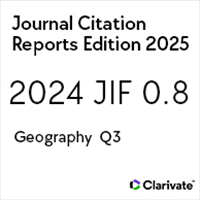Conexión tradicional: los vínculos mayas entre el altiplano de Guatemala y El Norte
Crafting connections: maya linkages between Guatemala’s Altiplano and El Norte
https://doi.org/10.21670/ref.2004.10.a04
Palabras clave:
Migración transnacional, redes sociales, migración de guatemaltecos maya, comunicaiones, organización a nivel localResumen
La migración internacional constituye uno de los fenómenos más significativos que afectan a Guatemala hoy en día. Casi un millón y medio de guatemaltecos viven y trabajan en grandes ciudades o en comunidades rurales y pueblos de los Estados Unidos y Canadá. Al igual que muchos otros grupos migrantes, lamayoría de los guatemaltecos mantienen fuertes lazos entre su país natal y el norte (los Estados Unidos). Según el ejemplo que se resalta en este artículo, dichos lazos se deben en gran medida: a las conexiones históricas que se han mantenido entre Guatemala y los Estados Unidos desde hace muchos años, a la disponibilidad hoy en día de medios de comunicación y de transporte más eficientes, y a la proximidad geográfica del país centroamericano con los Estados Unidos. Mediante la recopilación de material etngráfico, este artículo examinará los tipos divergentes de conexiones transnacionales que los indígenas migrantes mayas (K´iche´) establecen y mantienen vivas entre su país natal y los dos destinos principales ubicados en los Estados Unidos: Houston, Texas y Los Ángeles, California. Este artículo muestra los diferentes medios de comunicación y tecnología. así como los diversos tipos de organizaciones transnacionales, principalmente los esfuerzos por conservar sus raíces, que es lo que ayuda a conformar los lazos entre los que se van y los que se quedan.Abstract International migration constitutes one of the most significant phenomena impacting Guatemala today. About a million and a half Guatemalans live and work in rural and urban cities and towns across the United States and Canada. Like many other migrant groups, most Guatemalans sustain strong transnational linkages between their homeland and el norte (the United States). In the Guatemalan example highlighted in this article, such bonds owe much to the long-standing Guatemalan-U.S. historical connections, to the geographic proximity of the country to the United States. Drawing on ethnographic material, this article examines the divergent kinds of transnational connections that Maya indigenous (K´iche´) migrants craft and keep alive between their home community and their two primary destination localities in the United States—Houston, Texas and Los Angeles, California. The article shows the different means of communication and technology, as well as the varying types of transnational organizing —particularly grass-roots efforts— that help shape current linkages between those who go and those who stay. Keyword: Transnational migration, social ties, Guatemalan Maya migration, communications, grass-roots organizing.
Citas
Appadurai, Arjun. 1996. Modernity at Large: Cultural Dimensions of Globalization. University of Minnesota Press. Minneapolis.
Bailey, Adrian, et al. 2002. “(Re)producing Salvadoran Transnational Geographies”. Annals of the Association of American Geographers no. 92, vol. 1, pp. 125-144. DOI: https://doi.org/10.1111/1467-8306.00283
Burns, Allan. 1993. Maya in Exile: Guatemalans in Florida. Temple University Press. Philadelphia.
Carmack, R., ed. 1988. Harvest of Violence: The Maya Indians and the Guatemalan Crisis. Norman, University of Oklahoma Press.
Castillo, Manuel Angel. 1999. “Exodus and Return with a Changing Migration System”. In Journeys of Fear: Refuge Return and National Transformation in Guatemala. L.L. North and A. Simmons, eds. McGill-Queen’s University Press. Montreal, pp. 130-154.
Chance, John. 1996. “Mesoamerica’s Ethnographic Past”. Ethnohistory no. 43, vol. 3, pp. 379-403. DOI: https://doi.org/10.2307/483450
Fink, Leon. 2003. The Maya of Morganton: Work and Community in the Nuevo New South. Chapel Hill. University of North Carolina Press. DOI: https://doi.org/10.5149/uncp/9780807854471
Glick Schiller, Nina, Linda Basch, and Cristina Szanton Blanc (eds.). 1992. Towards a transnational perspective on migration: Race, class, ethnicity, and nationalism reconsidered. New York Academy of Sciences. New York. Volume 645.
Goldring, Luin. 1998. “The Power of Status in Transnational Social Fields”. In Transnationalism from Below. M.P. Smith and L.E. Guarnizo (eds.), Transaction Publishers. News Brunswick. vol. 6.
Guarnizo, Luis, and M. P. Smith. 1998. “The Locations of Transnationalism”. In Transnationalism from Below. M.P. Smith and L. Guarnizo (eds.), pp. 3-34. Comparative Urban & Community Research, Vol. 6. New Brunswick: Transaction Publishers.
Hagan, Jaqueline. 1994. Deciding to Be Legal: A Maya Community in Houston. Temple University Press. Philadelphia.
Hamilton, Nora, and Norma Chinchilla. 1999. “Changing Networks and Alliances in a Transnational Context: Salvadoran and Guatemalan Immigrants in Southern California”. Social Justice, no. 26, vol. 3, pp. 4-26.
Hamilton, Nora, and Norma Stoltz Chinchilla. 2001. Seeking Community in a Global City: Guatemalans and Salvadorans in Los Angeles. Temple University Press. Philadelphia.
Instituto de Estadísticas Económicas. 2002. Canasta Básica.
Instituto Nacional de Estadísticas. 1994. Censo de Población.
Kearney, Michael. 1995. “The Local and the Global: The Anthropology of Globalization and Transnationalism”. Annual Review Anthropology, no. 24, pp. 547-65. DOI: https://doi.org/10.1146/annurev.an.24.100195.002555
Kendall, Carl, John Hawkins, and Laurel Bossen, eds. 1983. Heritage of Conquest, Thirty Years Later. University of New Mexico Press. Albuquerque.
Landolt, Patricia, Lilian Autler, and Sonia Baires. 1999. “From Hermano Lejano to Hermano Mayor: The Dialectics of Salvadoran Transnationalism”. Ethnic and Racial Studies, no. 22, vol. 2, pp. 290-315. DOI: https://doi.org/10.1080/014198799329495
Lewis, Oscar. 1960. Tepoztlán: Village in Mexico. Holt, Rinehart and Winston, Inc. Orlando.
Loucky, James and Marilyn Moors, eds. 2000. Maya in the Diaspora: Guatemalan Roots, New American Lives. Temple University. Philadelphia.
Lovell, George. 1988. “Surviving Conquest: The Maya of Guatemala in Historical Perspective”. Latin America Research Review, no. 23, vol. 2, pp. 25-57. DOI: https://doi.org/10.1017/S0023879100022202
Lovell, George. 1999. “Land and Peace: Two Points of View”. In Journeys of Fear: Refuge Return and National Transformation in Guatemala. L.L. North and A. Simmons, eds. McGill-Queen’s University Press. Montreal, pp. 40-54.
Lovell, George and Christopher Lutz. 1994. “Conquest and Population: Maya Demography in Historical Perspective”. Latin America Research Review, no. 29, vol. 2, pp. 133-140. DOI: https://doi.org/10.1017/S0023879100024158
Manz, Beatriz. 1998. Refugees of a Hidden War: The Aftermath of Counterinsurgency in Guatemala. State University of New York Press. Albany.
Menjívar, Cecilia. 1999. “The Intersection of Work and Gender”. American Behavioral Scientist, no. 40, vol. 4, pp. 601-627. DOI: https://doi.org/10.1177/00027649921954381
Montejo, Víctor. 1999. “Tied to the Land: Maya Migration, Exile, and Transnationalism”. In Identities on the Move, Transnational Process in North American and the Caribbean Basin. L. Goldin, ed. Institute for Mesoamerican Studies, University at Albany. Albany, vol. 7, pp. 185-202.
Moran-Taylor, Michelle J., and Miles Richardson. 1993. “Place and Journey in the Lives of Guatemalan Migrants: Documenting the Undocumented”. Southern Anthropologist, no. 20, vol. 3, pp. 12-22.
Moran-Taylor, Michelle J. and Cecilia Menjívar. n.d. “Unpacking Longings of Return: Guatemalans and Salvadorans in Phoenix”, Arizona. Manuscript under review. Mimeo
Mountz, Alison, and Richard Wright. 1996. “Daily Life in the Transnational Migrant Community of San Agustin, Oaxaca, and DOI: https://doi.org/10.1353/dsp.1996.0017
Poughkeepsie, New York”. Diáspora, no. 5, vol. 3, pp. 403-427.
Municipalidad de San Cristóbal. 1998. Censo Urbano.
Nagengast, Carole, and Michael Kearney. 1990. “Mixtec Ethnicity: Social Identity, Political Consciousness, and Political Activism”. Latin American Research Review, no. 25, vol. 2, pp. 61-91. DOI: https://doi.org/10.1017/S0023879100023384
Nelson, Diane. 1999. A finger in the Wound, Body Politics in Quincentennial Guatemala. University of California Press. Berkeley.
Nolin Hanlon, Catharine. 1999. “Guatemalan refugees and returnees: Place and Maya Identity”. In Journeys of Fear: Refugee Return and National Transformation in Guatemala. L. North and A. Simmons (eds.). McGill-Queen’s Press. Montreal and Kingston, pp. 213-234.
Ochoa García, Carlos. 2001. “Migraciones de un pueblo K’iche’ hacia Houston”. In Migration Guatemala-Mexique. P. Petrich (ed.). Universite de Paris. Paris. DOI: https://doi.org/10.4000/alhim.588
Popkin, Eric. 1999. “Guatemalan Mayan migration to Los Angeles: Constructing transnational linkages in the context of the settlement process”. Ethnic and Racial Studies, no. 22, vol. 2, pp. 267-89. DOI: https://doi.org/10.1080/014198799329486
Prensa Libre. 2003. “En EE.UU. viven 1 millón 172,391 guatemaltecos”. Guatemala City.
Rodríguez, Nestor and Jaqueline Hagan. 2000. “Maya Urban Villagers in Houston: The Formation of a Migrant Community from San Cristóbal Totonicapan”. In The Maya Diaspora: Guatemalan Roots, New American Lives. J. Loucky and M. Moors (eds.). Temple University Press. Philadelphia, pp. 197-209.
Sassen-Koob, Saskia. 1979. “Formal and Informal Associations: Dominicans and Colombians in New York”. International Migration Review, no. 13, vol. 2, pp. 314-332. DOI: https://doi.org/10.1177/019791837901300209
Siems, Larry. 1992. Between the Lines: Letters between Undocumented Mexican and Central American Immigrants and their Families and Friends. University of Arizona Press. Tucson.
Smith, Carol. 1990. “Class Position and Class Consciousnesss in an Indian Community: Totonicapan in the 1970s”. In Guatemalan Indians and the State, 1540-1988. C. Smith (ed.). University of Texas Press. Austin, pp. 205-29. DOI: https://doi.org/10.7560/727441-014
Taylor, Matthew, Michelle Moran-Taylor, and Debra Rodman-Ruiz Forthcoming. “Land, Ethnic, and Gender Change: Transnational Migration and its Effects on Guatemalan Lives and Landscapes”. Geoforum.
Vlach, Norita. 1992. The Quetzal in Flight: Guatemalan Immigrant Families in the United States. Praeger Publishers. San José.
Warren, Kay. 1978. The Symbolism of Subordination: Indians in Guatemala. University of Texas Press. Austin.
Watanabe, John. 1992. Maya Saints and Souls in a Changing World. University of Texas Press. Austin.
Watanabe, John. 2000. “Maya and Anthropologists in the Highlands of Guatemala since the 1960s”. In Supplement to the Handbook of Middle American Indians: Ethnology. University of Texas Press. Austin, vol. 6, pp. 224-248. DOI: https://doi.org/10.7560/708815-012
Wellmeier, Nancy. 1998. Ritual, Identity, and the Mayan Diaspora. Garland Publishing, Inc. New York.































